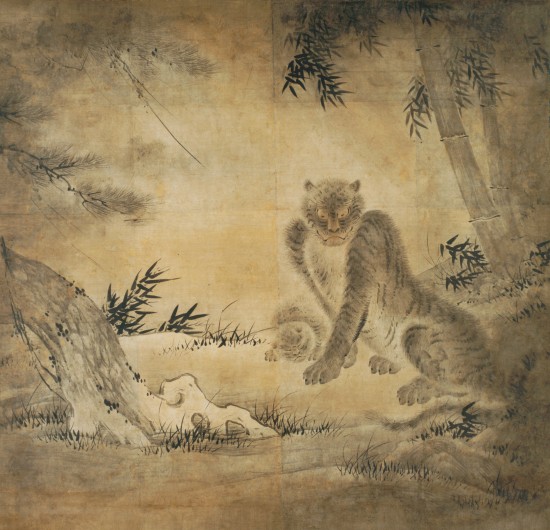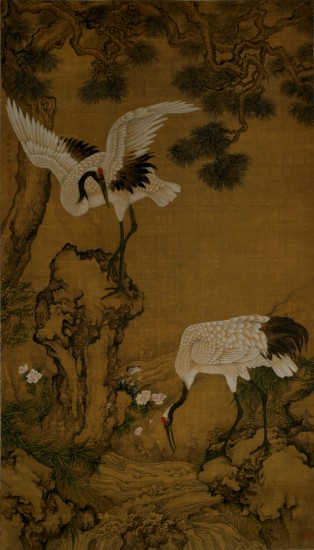From Hara Museum ARC (Gunma)
Hara Museum ARC is blessed with many varieties of cherry trees which blossom at different times. The double-flowered yaezakura now in bloom make this a particularly wonderful time for a visit.
From Friday, April 26, a new exhibition will be on view at the Kaikan Pavilion. As its name indicates, Flowers, Birds and Animals – Selections from the Hara Rokuro Collection showcases masterworks of bird-and-flower painting, including monochrome ink paintings by the Kano school and richly colored hanging scrolls by Shen Nanping (b. 1682-death unknown). These works are shown together with selected works of contemporary art from the Hara Museum Collection.
Bird-and-flower painting is a genre that originated in China. It includes not only bird and flower motifs, but also insects and animals. When it was first adopted in Japan, it was under the stylistic influence of China. During the Momoyama period, the Kano and Hasegawa schools developed a more decorative style. The motifs of this genre were widely adopted in paintings done for temple buildings and other large structures.

Tiger in a bamboo grove (part of paintings used for wallpaper and sliding doors at Nikko-in guest hall in Mi’idera temple), Kano Eitoku, Momoyama period
This hanging scroll was originally a partition painting (shohekiga) within the Nikko-in (guest hall) at Mi’idera (Onjoji) Temple in Shiga Prefecture. Such paintings were originally pasted onto the wall or panel (kabe haritsuke-e). This one was later converted into a scroll painting. The tiger is a symbol of wealth, high status, fertility and family prosperity and is an often-depicted subject in pictures of auspicious symbolism.
Bird-and-flower painting was widely done by every school of painting during the Edo period, including the Tosa, Rinpa, Maruyama Shijo schools, as well as by the literati school. The detailed realism introduced by the Chinese painter Shen Nanpin was actively adopted by Edo-period painters and a fusion of the various approaches occurred, leading to the creation of new styles.

A pair of cranes, Shen Nanping, Qing dynasty
Shen Nanping used rich colors to depict various motifs in his paintings, such as cranes in a pine tree and ever blooming rose. They represent the wish for long life, fertility and family prosperity.
Ranging from the early-modern era to the present day, the works presented in this exhibition represent a wide range of styles and expressions. What is common is their use of particular motifs as symbolic messages. We invite you to come take in the beauty of these paintings, and the cherry blossoms as well.
Featured Works
Traditional Art: Tiger in a bamboo grove (part of paintings used for wallpaper and sliding doors at Nikko-in guest hall in Mi’idera temple), Kano Eitoku, Momoyama period / Birds and flowers (part of paintings used for wallpaper and sliding doors at Nikko-in guest hall in Mi’idera temple,) attributed to Kano school, Momoyama – Edo period / A pair of cranes and an old pine tree, Shen Nanping, Qing dynasty and others
Contemporary Art: Kazumasa Nagai, SARU, 1991 / Yoshihiro Suda, Tessen, 2001 / Kouichi Tabata, 960 fly, 2003 / Hiroe Saeki, Untitled, 2009 and others
Kankai Pavilion (Traditional East Asian Art)
Elegant Pastimes – Selections from the Hara Rokuro Collection
March 16 (Saturday) – April 24 (Wednesday), 2013
Flowers, Birds and Animals – Selections from the Hara Rokuro Collection
April 26 (Friday) – May 29 (Wednesday), 2013
Galleries A, B and C (Contemporary Art)
Spinning the Word: Sophie Calle and Miranda July from the Hara Museum Collection
March 16 (Saturday) – June 26 (Wednesday), 2013
———-
Hara Museum ARC
2855-1, Kanai, Shibukawa-shi, Gunma 377-0027 Tel: 0279-24-6585
Fax: 0279-24-0449
Hours: 9:30 am – 4:30 pm *Last entry 30 minutes before closing.
Closed: Thursdays (except March 28 and May 2) *Closed temporarily in the event of severe weather.
Admission: General (over 12) 1,000 yen; children (over 3) 500 yen; 10% discount for a group of 20 or more; a 100 yen discount with the Hara Museum ticket.
*Children must be accompanied by an adult. *Combination ticket for Hara Museum ARC and Ikaho Green Bokujo ranch: General 1,800 yen; Children 900 yen.
Getting There: By train: Take the Joetsu Shinkansen to Takasaki, change to the Joestu Line, and disembark at Shibukawa. From Shibukawa, ARC is 10 minutes away by taxi or 15 minutes by bus (take the Ikaho Onsen bus to “Green Bokujo Mae”). By car: 8 kilometers (about 15 minutes) from the Kan-etsu Expressway Shibukawa Ikaho Interchange (in the direction of Ikaho Onsen).
